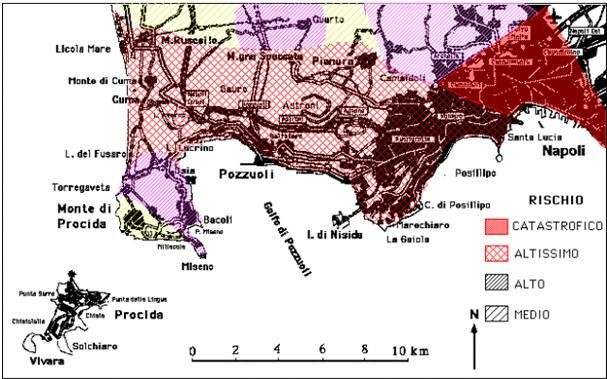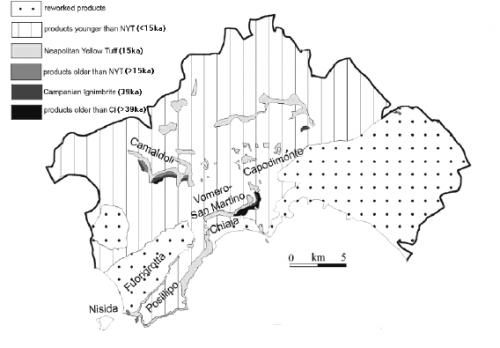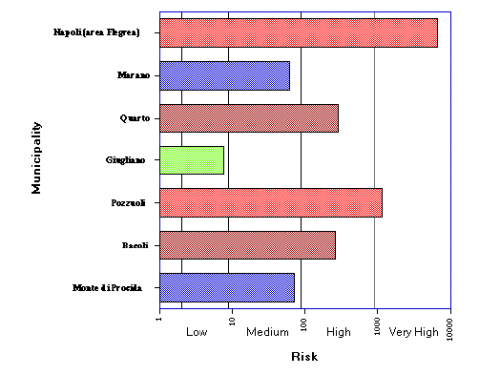Neapolitan urban area and Campi Flegrei district represent a wide active volcanic system to which a very high volcanic risk is associated. This risk is defined as the product of the hazard (probability that an area be interested by volcanic phenomena in a given time interval) times the quantity of damages that can be provoked. That risk is catastrophic or very high in the city of Naples (Fig. 1): notwithstanding that, because of the heavy urbanization, the geological structure of the outcropping deposits has been examined with much more difficulties as respect to the remnant part of the Phlegraean area.

Fig. 1 - The volcanic risk in the Campi Flegrei and in the city of Naples
The volcanic nature of the Phlegraean area was already recognized during the Greek-Roman epoch. In 1904, the first stratigraphic reconstruction of the area was carried out, and the eruptive activity was subdivided in three periods. Further studies allowed inclusion of the Neapolitan Yellow Tuff eruption in the second period, and that of the Campanian Ignimbrite in the first period. The intensity of these two main eruptions was impressive: the Neapolitan area was totally buried by tenths to hundreds of cubic kilometres of pyroclastic fragments (volcanic blocks of ashes, lapilli, or bombs, ejected during an explosive eruption). As a proof of the eruptions, two concentric calderas that closes beneath the sea were recognized in the continental part of the Campi Flegrei. The external caldera is associated to the Campanian Ignimbrite, occurred 39000 years ago, while the internal one to the Neapolitan Yellow Tuff, occurred 15000 years ago.
Only recently, a detailed stratigraphic reconstruction of the volcanic history of Naples was proposed. The deposits outcropping in the Neapolitan area present an age interval between about a few to thousands years old. That analysis has been enriched through the evaluation of the absolute age of the deposit (geochronological analysis). The evaluation of the ages has been carried out through the method based on the calculation of the ratio argon40/argon39, argon isotopes that originate from the radioactive decay of the potassium-40 and potassium-39. The stratigraphic and geochronological reconstruction made clear that the volcanism of the city of Naples (Fig. 2) has evolved in time in a manner very similar to that of Campi Flegrei. Hence, the geochronological analysis is one of the fundamental methods to investigate on the volcanic risk.

Fig. 2 - The geochronological succession of the deposits in the city of Naples
The Campi Flegrei area is also known for secondary volcanic phenomena as the bradyseism. The bradyseism consists in a periodic drawdown or rising of the ground level, usually of almost 1 cm per year, relatively slow on the human time scale but very fast as respect to the geological periods. The ground rising for the effect of the bradyseism was extremely intense in the XVI century: in 1538, after a rising of about 7 metres, the phenomenon culminated with the Monte Nuovo eruption. In much more recent times, a remarkable bradyseism occurred in Pozzuoli in the two periods between 1970 and 1972 (the ground raised of about one meter), and between 1982 and 1984 (with a rising of about two meters). That led to the forced evacuation of Rione Terra (a popular historical neighbourhood of Pozzuoli): thirty thousand people were evacuated from Pozzuoli and transferred in the new buildings constructed at Rione Toiano and Monteruscello, about three kilometres far away. Many doubts have been raised on the effectiveness of the measures adopted for the population safety, especially because the new residential areas are still located inside the Campi Flegrei caldera. Nowadays, since 2005, the Campi Flegrei has begun a new bradyseism phase of a more minor entity. Despite long-lasting detailed studies on this phenomenon, its origin is still very controversial: only recently a geophysical model was proposed to explain its causes.
In conclusion, the Phlegraean area is reckoned as on of the areas with a higher volcanic risk. The main reason is that a possible eruptive event will be probably characterized by a high explosiveness. The volcanic vents could open everywhere in the area, with the risk of a ruinous eruption in densely inhabited districts. Very recently, a probabilistic model to evaluate the volcanic risk in the Phlegraean area was proposed. In the absence of a central apparatus from which an eruptive event could be expected, the plot reported in Fig. 3 is useful to visualize the risk indication of an eruption expected for each municipality. Considering that, for all reported municipality, the number of inhabitants is large, to reduce the risk to acceptable values, it would be necessary a drastic reduction of the residential settlements. That does not seem feasible for the social and economics high costs.

Fig. 3 - Evaluation of the expected eruption risk in the Phlegraean area
References
Gasparini P., Mantovani M. S. M.: "Fisica della Terra Solida", Liguori editore, 1984.
Scandone R., D'Andrea M.: "Il rischio vulcanico", in Di Donna V., Vallario A.: "L'ambiente : Risorse e rischi", Liguori editore, Napoli, 130-150, 1994.
Di Vito M. A., Isaia R., Orsi G., Southon J., de Vita S., M. D’Antonio, Pappalardo L., Piochi M., 1999: "Volcanism and deformation since 12,000 years at the Campi Flegrei caldera (Italy)", J. Volcanol. Geotherm. Res., 91, 221-246.
Perrotta A., Scarpati C.: "Volume partition between the plinian and co-ignimbrite air fall deposits of the CI eruption", Miner. Petrol., 79, 67-78, 2003.
Scarpati C., Cole P. D., Perrotta A.: "The Neapolitan Yellow Tuff - A large volume mutiphase eruption from Campi Flegrei, Southern Italy", Bull. Volcanol., 55, 343-356, 1993. Cole P. D, Perrotta A., Scarpati C.: "The volcanic history of the southwestern part of the city of Naples", Geol. Mag., 131, 785-799, 1994.
Scarpati C., Perrotta A., Lepore S., Calvert A.: "Eruptive history of Neapolitan volcanoes: constraints from 40Ar/39Ar datings", Geol. Mag., GEO-12-0847, 2012. Dalrymple G. B., Alexander C. JR., Lanphere M. A., Kraker G. P.: "Irradiation of samples for 40Ar/39Ar dating using the Geological Survey TRIGA reactor", U.S. Geological Survey, Professional Paper 1176, 1981.
De Vivo B., Lima A., Bodnar R. J., Milia A., Spera F. J.: "Il rischio eruzione nei Campi Flegrei", Le Scienze, 496, 96-103, 2009 Selva J., Orsi G., Di Vito M. A., Marzocchi W., Sandri L.: "Probability hazard map for future vent opening at the Campi Flegrei caldera, Italy", Bull. Volcanol., 74, 497-510, 2012.

